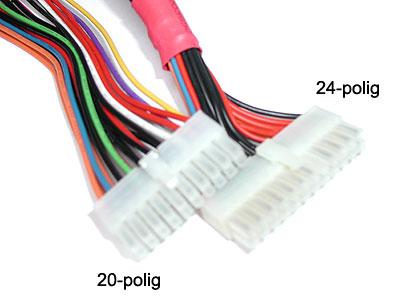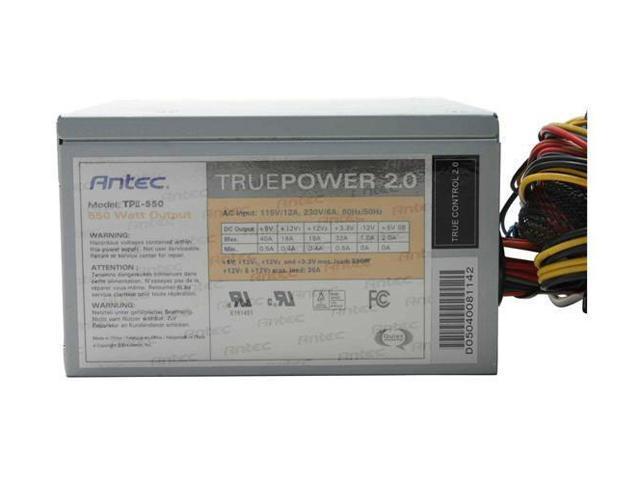Section 03 - I'm lazy! Which PSUs do you recommend?
Budget
PSUs in this category must meet the following criteria
- Cost less than $50
- Must provide at least 18A on the 12V rail
- Must provide the minimum 16ms hold-up time
- Must provide a net of 400W
- Must be either 24p or 20+4p
Since these are going to be the bottom of the barrel PSUs (in terms of quality), I'll probably stay away from modular and/or "silent" PSUs -- the goal is to find a quality PSU for as little money as possible ... if you're looking for a bling-bling PSU on a tiny budget, this guide isn't for you.
HIPRO HP-430PA3 True 400W
Cost: $19.99
Rails: +3.3V@27A, +5V@22A,
+12V@[14+13]A
Mobo: 24p
Cooling: 1x80mm
Comments: Dirt cheap, some pretty impressive on-paper specs, this is a hell of a PSU for it's price. Although I originally noted that the minimum spec for PSUs would be 18A on the +12V line, this PSU really sets the bar high especially for the price.
Logisys PS550ABK 550W
Cost: $19.99
Rails: +3.3V@30A, +5V@38A,
+12V@25A
Mobo: 24p
Cooling: 2x80mm
Comments: Nothing too brilliant about this PSU other than it's price tag. I included it as a price-point alternative in case the HiPRO goes out of stock.
HIPRO HP-E4009F5WR ATX V2.0 True 400W
Cost: $28.99
Rails: +3.3V@30A, +5V@28A,
+12V@[14+15]A
Mobo: 20+4p
Cooling: 1x120mm
Comments: A solid enough PSU with an appealing pricetag.
Rosewill RV450-2 450W
Cost: $31.99
Rails: +3.3V@30A, +5V@45A,
+12V@[17+16]A
Mobo: 20+4p
Cooling: 2x80mm
Comments: A fairly solid PSU all around.
HIPRO HP-P500W/TOP-500P5 500W
Cost: $36.50
Rails: +3.3V@28A, +5V@44A,
+12V@[20+20]A
Mobo: 20+4p
Cooling: 1x120mm
Comments: A fairly solid PSU, with a total +12V@29A.
XClio 450BL 450W *** Praetor's Pick ***
Cost: $39.99
Rails: +3.3V@32A, +5V@30A,
+12V@[15+17]A
Mobo: 20+4p
Cooling: 1x120mm
Comments: One of my most popular recommended PSUs this PSU has it all for the price bracket (tight voltage regulation, 20ms hold-up, high power efficiency, solid rails). This PSU is highly recommended.
Coolmax CR-450W 450W
Cost: $42.99
Rails: +3.3V@30A, +5V@45A,
+12V@[17+16]A
Mobo: 20+4p
Cooling: 1x140
Comments:With the larger fan, this is a good low-budget noise-optimized PSU that doesn't sacrifice performance
Midrange
Since I was pleasantly surprised by the some of the decent PSUs I rounded up in the previous category, the bar has definitively been raised for this bracket. PSUs recommended here must
- Cost less than $75
- Provide 28A or better on the +12V line
- Aim for ±3% voltage tolerance
- Must either be 24p or 20+4p
- Provide a minimum of 500W net load
Athena Power AP-P4ATX50F12 EPS12V 500W
Cost: $49.50
Rails: +3.3V@35A, +5V@61A,
+12V@28A
Mobo: 20+4p
Cooling: 1x120mm+1x80mm
Comments: A decent PSU all around, the PSU gets both exceptional cooling as well as not generating significant noise.
Coolmax CP-500T EPS12V 500W
Cost: $49.99
Rails: +3.3V@30, +5V@50A,
+12V[16+18]A
Mobo: 24p
Cooling: 1x120mm
Comments: Another solid PSU, this one qualifies for EPS12V systems and also features Active PFC.
Atrix PSAX-550BL 550W
Cost: $49.99
Rails: +3.3V@32A, +5V@40,
+12V@[19+20]A
Mobo: 20+4p
Cooling: 1x120mm
Comments: A very robust PSU with some very impressive stats however the MTBF stands out: the 25ºC ambient temperature that it (the MTBF) is measured at is significantly lower than the operating temperature that PSUs usually run at
XClio GOODPOWER 500W
Cost: $51.99
Rails: +3.3V@30A, +5V@28A,
+12V@[16+17]A
Mobo: 20+4p
Cooling: 1x120mm
Comments: For those that crave it, this PSU has SLI Certification but more importantly, is a solid PSU.
Rosewill RP550-2 500W
Cost: $54.99
Rails: +3.3V@30, +5V@50A,
+12V[18+18]A
Mobo: 20+4p
Cooling: 1x120mm
Comments: This is a bling bling PSU without sacrificing both quality or noise. No complaints here, a solid recommendation all around.
Rosewill RP500-2 500W
Cost: $58.99
Rails: +3.3V@30, +5V@45A,
+12V[18+16]A
Mobo: 20+4p
Cooling: 1x120mm
Comments: This is a bling bling PSU without sacrificing both quality or noise. No complaints here, a solid recommendation all around.
Rosewill RT550-135-BK 550W
Cost: $59.99
Rails: +3.3V@30A, +5V@25A,
+12V@[17+18]A
Mobo: 20+4p
Cooling: 1x135mm
Comments: EPS12V certified and SLI ready. A robust, quality PSU.
Sunbeam NUUO SUNNU550-US-SV550W *** Praetor's Pick ***
Cost: $59.99
Rails: +3.3V@28A, +5V@36A,
+12V@[20+18]A
Mobo: 20+4p
Cooling: 1x80mm+1x120mm
Comments: Tight ±3% voltage regulation, Active PFC, SLI Certified, PSU is very solid all around and if the 3.3v line was slightly more robust, could be a contender for the next category.
Enhance ENP-5150GH 500W
Cost: $69.01
Rails: +3.3V@25A, +5V@20A,
+12V@[18+18]A
Mobo: 20+4p
Cooling: 1x120mm
Comments: 80+ certified, EPS12V certified, Active PFC and SLI ready. Without a doubt one of the best PSUs in this catagory.
XCLIO STABLEPOWER 500W
Cost: $69.99
Rails: +3.3V@30A, +5V@30A,
+12V@[18+18]A
Mobo: 20+4p
Cooling: 1x140mm
Comments: Although, IMO, not quite as good as the Enhance unit directly above, this is easily available from newegg and remains an excellent quality unit.
Enthusiast
PSUs in this bracket don't have a price limitation but they do have some stringent requirements
- Must have an exceptional and well known record of solid performance. This is by far the most important requirement.
- Must have a minimum of 36A on the 12V line spread over at least two rails
- Must provide an excess of 500W net
- Must have two PCI-Express connectors
- High preference for adjustable rails
- HIgh preference for ±3% voltage regulation
- High preference given for longer warranties
- Must have some form of PFC either active or passive
In short, this list will be incredibly picky and every speci will be taken into consideration.
Antec NeoHE 500W
Cost: $99.99
Rails: +3.3V@23A, +5V@17A,
+12V@[17+17+17]A
Voltage Regulation: ±3% marketed, ±1% common
MTBF: 80,000+ @ 50ºC
Hold-up: 20ms
PFC: Active
Mobo: 20+4p
Warranty: 3 years
Cooling: 1x80mm
Features: SLI Certified, Modular
Comments: The NeoHE series of boards has a known issue with some last generation ASUS boards (which, I believe have been addressed by ASUS/Antec)
Antec NeoPower NeoHE 550W
Cost: $109.99
Rails: +3.3V@24A, +5V@20A,
+12V@[18+18+18]A
Voltage Regulation: ±3% marketed, ±1% common
MTBF: 80,000+ @ 50ºC
Hold-up: 20ms
PFC: Active
Mobo: 20+4p
Warranty: 3 years
Cooling: 1x80mm
Features: SLI Certified, Modular
Comments: As same with the 500W model of this series, there are known issues (which I believe have been addressed) with using the NeoHe series of PSUs with certain high end ASUS motherboards
OCz GameXStream 600W
Cost: $114.99 (after $25.00 MIR)
Rails: +3.3V@36A, +5V@30A,
+12V@[18+18+18+18]A
Voltage Regulation: ±5% marketed, ±1% effective
MTBF: 100,000+ @ 25ºC
Hold-up: 17ms
PFC: Active
Mobo: 24p
Warrany: 3-year
Cooling: 1x120mm
Features: Crossfire Ready
Comments: Building upon the very well esteemed PowerStream series, this lineup switches to a 24p connector, adds PFC and quad rails (the PowerStream600W had dual rails however)
OCz GameXStream 700W
Cost: $119.99 (after $35.00 MIR)
Rails: +3.3V@36A, +5V@30A,
+12V@[18+18+18+18]A
Voltage Regulation: ±5% marketed, ±1% effective
MTBF: 100,000+ @ 25ºC
Hold-up: 17ms
PFC: Active
Mobo: 24p
Warrany: 3-year
Cooling: 1x120mm
Features: Crossfire Ready
Comments: With a greater total +12V output than its 600W sibling, this PSU is extremely robust and definitively one of the best in this category.
Corsair HX520W
Cost: $119.99
Rails: +3.3V@24A, +5V@24A,
+12V@[18+18+18]A
Voltage Regulation: ±5% marketed, 1% common
MTBF: 100,000+ @ 50ºC
Hold-up: 16ms
PFC: Active
Mobo: 20+4p
Warranty: 5 years
Cooling: 1x120mm
Features: SLI Certified, Modular
Comments: Despite being labeled to the contrary, this unit is capable of putting as much of the total +12V@40A on any rail as is required. Rated at 50ºC it is a superb PSU.
Corsair HX620W
Cost: $154.99 (after $15 MIR)
Rails: +3.3V@24A, +5V@30A,
+12V@[18+18+18]A
Voltage Regulation: ±5% marketed, 1% common
MTBF: 100,000+ @ 50ºC
Hold-up: 16ms
PFC: Active
Mobo: 20+4p
Warranty: 5 years
Cooling: 1x120mm
Features: SLI Certified, Modular
Comments: With a greater total +12V output than its 520W sibling, this is a superb PSU.
XClio GreatPower X14S4P4 750W
Cost: $174.99
Rails: +3.3V@30A, +5V@28A,
+12V@[18+18+18+18]A
Voltage Regulation: ±3-4% marketed, 2% common
MTBF: 100,000+ @ 25ºC
Hold-up: 16ms
PFC: Active
Mobo: 20+4p
Warranty: 3 years
Cooling: 1x140mm
Features: SLI Certified, Modular, Adjustable Pots
Comments: Carrying on the expected high quality of some of the other XClio PSUs, this is no exception. It was a bit difficult finding some of the information however.
SILVERSTONE SST-ST75ZF 750W
Cost: $184.99
Rails: +3.3V@24A, +5V@30A,
+12V@[18+18+18+18]A
Voltage Regulation: ±5% marketed, 1% common
MTBF: 100,000+ @ 25ºC
Hold-up: 17ms
PFC: Active
Mobo: 20+4pin
Warranty: 3 years
Cooling: 1x80mm
Features: Active PFC, SLI Certified, EPS12V certified
Comments: A top quality unit.
Silverstone ST85ZF 850W
Cost: $244.99
Rails: +3.3V@24A, +5V@30A,
+12V@[18+18+18+18]A
Voltage Regulation: ±5% marketed, ±1% common
MTBF: > 100,000+ hours @ 25ºC
Hold-Up: 17ms
PFC: Active
Mobo: 24pin
Warranty: 3-year
Cooling: 1x80mm
Features: SLI Certified for all configurations, 4 PCI-E connectors.
Comments: A top quality unit, despite low efficiency at low loads
Silverstone OP1000 1KW
Cost: $344.99
Rails: +3.3V@30A, +5V@40A,
+12V@[80]A
Voltage Regulation: ±5% marketed, ±1% common
MTBF: > 100,000+ hours @ 25ºC
Hold-Up: 16ms
PFC: Active
Mobo: 24pin
Warranty: 3-year
Cooling: 1x80mm
Features: 6 PCI-E connectors.
Comments: Rated at 50C, this is a top quality 1KW PSU without the obscene pricetag of the PC P&C.
PC Power & Cooling TurboCool 1KW-SR
Cost: $549.00
Rails: +3.3V@24A, +5V@30A,
+12V@72A
Voltage Regulation: ±2% marketed, ±1% common
MTBF: 100,000+ @ 50ºC
Hold-up: 32ms
PFC: Active
Mobo: 24p
Warranty: 5-years
Cooling: 1x80mm
Features: SLI Certified
Comments: Replacing the older TurboCool 1KW, this unit features a powerful single +12V rail. This PSU thoroughly trumps most others in every single respect whether we judge by real-world tolerance, power load, MTBF, warranty and most impressively, hold-time (50% better!). The only downside is the obscene price tag.




